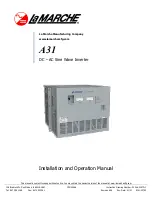
Operate the device only with a permanent connection to the public power grid. The country and grid type selection must
be commensurate with the respective location and grid type.
The requirements of the grid operator must be met for grid connection to take place. The permission of the relevant au-
thorities may also be required in order to secure authorisation to connection to the grid.
The name plate must be permanently attached to the product and must be in legible condition.
2.2
Improper use of the product
Any other or additional use is not considered proper or intended use and can lead to an annulment of the product guar-
antee. This includes:
Use of a distribution system that is not described (grid type)
Use of sources other than PV-strings.
Mobile use
Use in rooms where there is a risk of explosion
Use in direct sunlight, rain or a storm or other harsh environmental conditions
Use in an outdoor area that does not meet the environmental conditions set down in Technical Data/Environmental
Data in the comprehensive operating instructions
Operation outside the specification intended by the manufacturer
Overvoltage on the DC connection of over 1,000 V
Device modification
Standalone mode
2.3
Protection features
The following monitoring and protection functions are integrated in the device:
RCMU (Residual Current Monitoring Unit)
Overvoltage conductor / varistor to protect the power semiconductors from high-energy transients on the grid and
generator sides.
Device temperature monitoring system
EMC filter to protect the inverter from high-frequency grid interference
Grid-side varistors grounded to earth to protect the product against burst and surge pulses
Anti-islanding detection according to the current standards.
Isolation detection / residual current monitoring and disconnection function to detect isolation faults
NOTE
If the device is connected, the overvoltage conductors / varistors contained in the device have an impact
on the electrical system insulation resistance test as per HD 60364-6 / IEC 60364-6 Low-voltage installa-
tions- Part 6: Verification.
IEC 60364-6 6.4.3.3 describes two options for this case. The first option is to disconnect devices with an
overvoltage conductor or, if this is not practicable, then the test voltage can be reduced to 250V.
2.4
Warnings on the device
A warning sticker is affixed to the device, see the figure on the title page.
1 Read the warnings carefully
2 Do not remove the warning sticker.
3 If the warning sticker is missing or illegible, contact a KACO representative or dealer.
Article number: 22000270
Powador 30.0-72.0 TL3
Page 8
EN









































